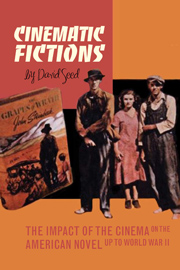Book contents
- Frontmatter
- Contents
- Introduction
- 1 Beginnings
- 2 Modernist Experiments: Gertrude Stein and Others
- 3 H.D. and the Limits of Vision
- 4 Ernest Hemingway: The Observer's Visual Field
- 5 Success and Stardom in F. Scott Fitzgerald
- 6 William Faulkner: Perspective Experiments
- 7 John Dos Passos and the Art of Montage
- 8 Dreiser, Eisenstein and Upton Sinclair
- 9 Documentary of the 1930s
- 10 John Steinbeck: Extensions of Documentary
- 11 Taking Possession of the Images: African American Writers and the Cinema
- 12 Into the Night Life: Henry Miller and Anaïs Nin
- 13 Nathanael West and the Hollywood Novel
- Bibliography
- Index
3 - H.D. and the Limits of Vision
- Frontmatter
- Contents
- Introduction
- 1 Beginnings
- 2 Modernist Experiments: Gertrude Stein and Others
- 3 H.D. and the Limits of Vision
- 4 Ernest Hemingway: The Observer's Visual Field
- 5 Success and Stardom in F. Scott Fitzgerald
- 6 William Faulkner: Perspective Experiments
- 7 John Dos Passos and the Art of Montage
- 8 Dreiser, Eisenstein and Upton Sinclair
- 9 Documentary of the 1930s
- 10 John Steinbeck: Extensions of Documentary
- 11 Taking Possession of the Images: African American Writers and the Cinema
- 12 Into the Night Life: Henry Miller and Anaïs Nin
- 13 Nathanael West and the Hollywood Novel
- Bibliography
- Index
Summary
Unlike the writers considered in the previous chapter, the poet and novelist H.D. (Hilda Doolittle) was actively involved in film-making for a time. Throughout her career she remained obsessively preoccupied with the visual but constantly pushed against the limits of visibility. ‘Vision’ was a term which oscillated in her works between the physical and the transcendental, and for her film was a crucial medium for exploring this border area. Although she witnessed the shooting of scenes for a Mary Pickford film in Carmel in 1920, her closest involvement in the cinema took place between 1927 and 1933, and in the midst of her enthusiasm she declared: ‘the world of the film to-day […] is no longer the world of the film, it is the world’. For H.D., as for Henri Bergson and Hugo Munsterberg, film offered a new means of articulating the dynamics of the mind. In H.D.'s writings from the late 1920s onwards, perception is repeatedly referred to as a quasi-cinematic process. For example, in the short sketch ‘Mira-Mare’ (written in 1930), while a female character is watching a man on a beach, we are told: ‘her narrowed squint widened like a camera shutter’. Sometimes H.D. sets up an opposition between mechanical and organic perception; often she refers to the eyes as if they were unusual lenses registering different dimensions of reality.
- Type
- Chapter
- Information
- Cinematic FictionsThe Impact of the Cinema on the American Novel up to World War II, pp. 49 - 67Publisher: Liverpool University PressPrint publication year: 2009



